How To Use Saline Drops For Babies: A Step-by-Step Guide
Have you ever felt the desperation of watching your baby struggle to breathe because of a blocked nose? As a parent, it’s a heart-wrenching experience. But what if there was a simple yet powerful solution right at your fingertips? Saline drops – the gentle yet effective remedy for your baby’s nasal congestion. But the question is do you know how to use saline drops for babies?
In our comprehensive guide, we’ll walk you through the step-by-step process of using saline drops to clear your baby’s blocked nasal passages. From understanding the benefits of saline drops to learning the safest administration techniques, we’ve got you covered. Say goodbye to those sleepless nights and hello to easier breathing for your little bundle of joy.
With our expert tips and insights, you’ll feel confident in addressing how to use saline drops for babies promptly and effectively. Let’s ensure your baby breathes easily and smiles again.
Introduction to Saline Drops for Babies
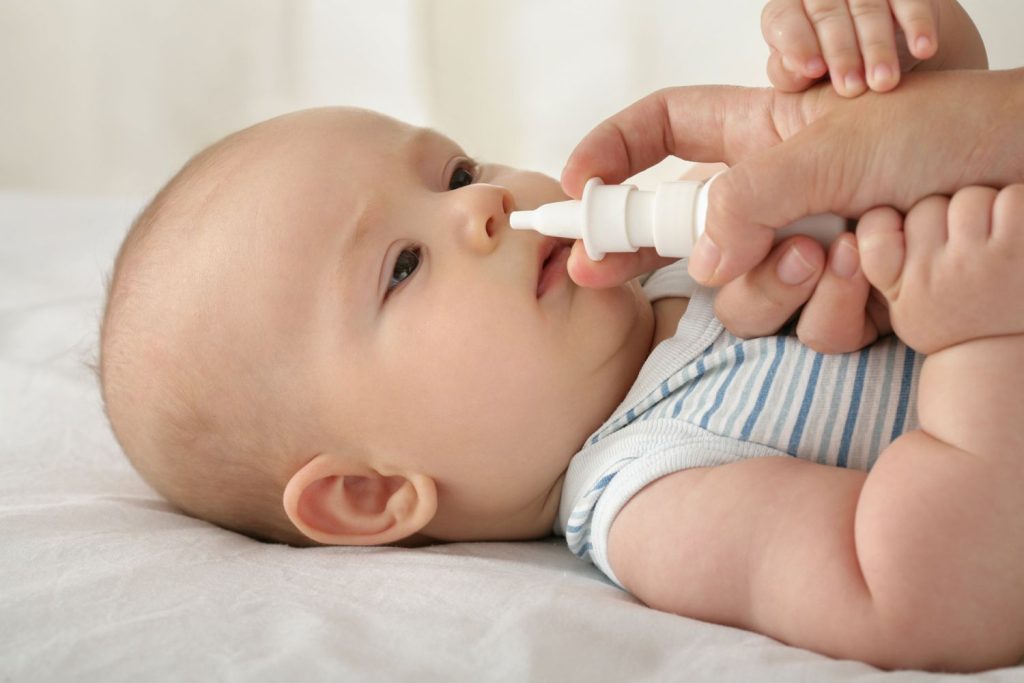
When your little one is suffering from a blocked nose, it can be difficult for them to breathe comfortably and may cause discomfort. Fortunately, saline drops can provide relief and help clear their nasal passages, allowing them to breathe more freely. In this section, we will provide you with a brief overview of what the article will cover and the benefits of using saline drops for relieving nasal congestion in babies.
Using saline drops is a safe and effective way to alleviate nasal congestion in infants. These drops are made up of a saline solution, which is essentially a combination of salt and water.
When administered correctly, saline drops can help to thin and loosen mucus, making it easier for your baby to breathe. Unlike medicated nasal sprays, saline drops have no active ingredients, making them suitable for newborns and infants.
The benefits of using saline drops for your baby’s blocked nose are numerous. They not only help to moisturize and soothe the nasal passages but also aid in clearing out excess mucus.
This can reduce your baby’s discomfort and improve their ability to feed and sleep. Saline drops are a gentle and non-invasive solution that can be used as often as needed without any harmful side effects.
In the following sections of this article, we will guide you through the process of using saline drops, including tips for ensuring safety, selecting the right product, and addressing common concerns.
By learning how to use saline drops for babies effectively and safely, you can help your baby breathe easier and provide them with much-needed relief from nasal congestion.
Understanding Infant Nasal Congestion
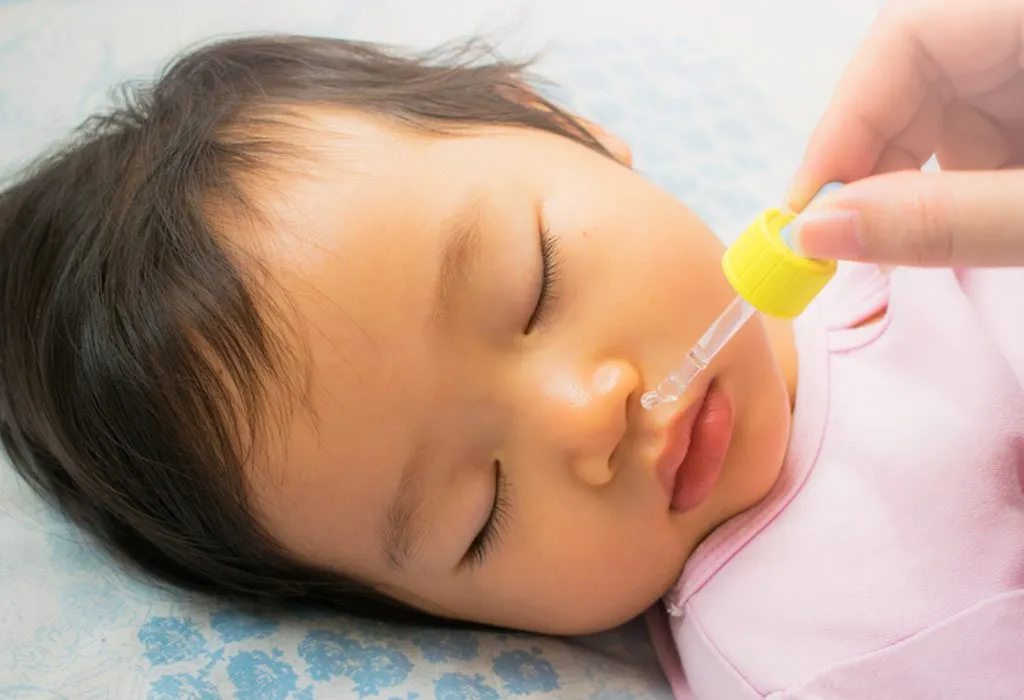
Infant nasal congestion can be a common concern for parents, causing discomfort and difficulty in breathing for their little ones. Understanding the causes and symptoms of nasal congestion in babies is crucial in effectively addressing this issue.
4 Major Causes of Infant Nasal Congestion
There are various factors that can contribute to nasal congestion in infants. Here are some common causes:
1. Viral Infections
Respiratory viruses, such as the common cold, can lead to nasal congestion in babies. These infections cause inflammation in the nasal passages, resulting in a stuffy nose.
2. Allergies
Some infants may experience nasal congestion due to allergies, such as dust mites, pet dander, or pollen.
3. Dry Air
Low humidity levels in the environment can cause the nasal passages to become dry, leading to congestion.
4. Teething
When babies are teething, the increased blood flow to the gums can cause swelling and congestion in the nasal passages.
4 Prime Symptoms of Infant Nasal Congestion
Identifying the symptoms of nasal congestion in infants is essential for timely intervention. Here are some signs to watch out for:
1. Difficulty Breathing
Babies with nasal congestion may struggle to breathe through their nose. You may notice increased mouth breathing or snoring sounds during sleep.
2. Runny or Stuffy Nose
Clear or thick nasal discharge is a common symptom of nasal congestion in infants.
3. Sneezing
Frequent sneezing can be a sign of nasal irritation and congestion in babies.
4. Restlessness and Discomfort
Infants with nasal congestion may have trouble sleeping, eating, or breastfeeding due to difficulty breathing.
Importance of Addressing Nasal Congestion
- Addressing nasal congestion in babies is crucial for their comfort and overall well-being.
- When left untreated, nasal congestion can impact a baby’s ability to nurse or bottle-feed.
- It can further disrupt their sleep patterns and potentially lead to ear infections or respiratory difficulties.
By understanding the causes and symptoms of nasal congestion, you can take appropriate steps to provide relief for your little one. In the next section, we will explore the selection and safe use of saline drops that can help alleviate nasal congestion in infants.
Choosing the Right Saline Drops
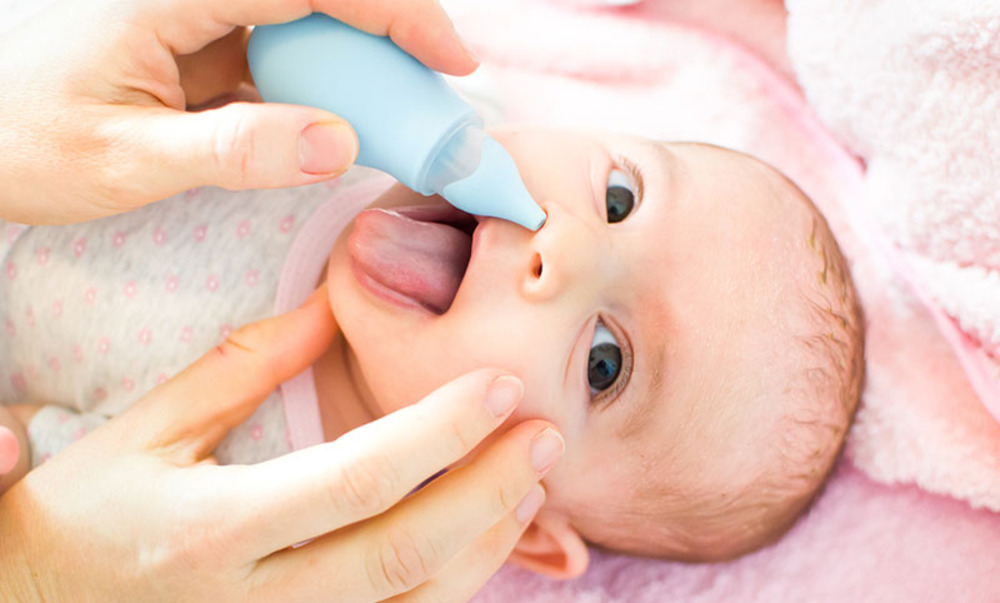
When it comes to selecting saline drops for your baby, it’s essential to choose a product that is safe, effective, and suitable for their age.
Here are some guidelines to help you make the right choice:
Consider Safety and Ingredients
- Opt for saline drops that are specifically formulated for infants and free from any harmful additives or preservatives.
- Look for products that are made with natural ingredients and have been approved by pediatricians or trusted medical organizations.
Age-Specific Recommendations
- Keep in mind that different age groups may require varying concentrations of saline.
- For newborns and young infants, it is recommended to use saline drops specifically labeled for their age range.
- As your baby grows, you can transition to drops appropriate for older infants.
Read Reviews and Recommendations
- Before purchasing any saline drops, take the time to read reviews and recommendations from other parents or trusted sources.
- Look for products that have received positive feedback for their effectiveness and ease of use.
Check Expiry Dates and Packaging
- Always check the expiry date on the saline drop packaging to ensure the product is still within its shelf life.
- Additionally, pay attention to the bottle design and nozzle, as a well-designed bottle can make administering the drops easier and more convenient.
By choosing the right saline drops for your baby, you can ensure their nasal congestion is effectively addressed while providing them with relief and comfort. Remember to consult your pediatrician if you have any specific concerns or questions about choosing the appropriate saline drops for your baby’s nasal congestion.
Preparing for Administration

Before administering saline drops to your baby, it is crucial to ensure proper cleaning and preparation of the nasal passage and drops.
Follow these steps to create a safe and comfortable environment for nasal congestion relief:
Cleanliness is Key
- Wash your hands thoroughly with soap and water before handling the saline drops or touching your baby’s face.
- Gently clean your baby’s nose with a soft, damp cloth or a saline wipe to remove any excess mucus or debris.
Gentle Nasal Passage Preparation
- Lay your baby flat on their back or at a slight incline.
- Tilt their head back slightly or use a rolled-up blanket to support their neck.
- Use a nasal aspirator, bulb syringe, or a specialized baby nasal suction device to gently clear any blockages from their nostrils.
Proper Saline Drop Preparation
- Check the expiration date on the saline drops bottle and ensure it is not past its prime.
- Shake the bottle well to ensure the saline solution is evenly mixed.
- If necessary, use a dropper or specialized bottle dispenser to control the amount of saline drops being administered.
Remember, always read and follow the instructions provided by the manufacturer for dosage and administration. By taking these precautionary measures, you can ensure a safe and effective experience when using saline drops for your baby’s nasal congestion relief.
Stay tuned for the next section, where we will provide a step-by-step guide on how to administer saline drops to your baby’s nose.
How To Use Saline Drops For Babies: Step-by-Step Guide
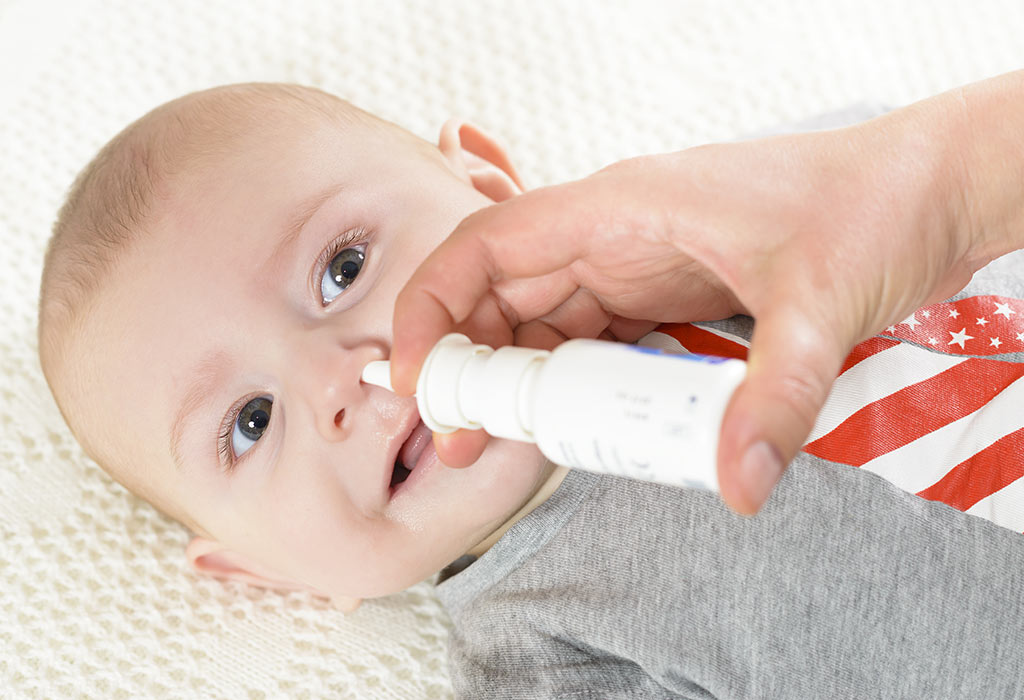
Administering saline drops to your baby’s nose can effectively alleviate nasal congestion and help them breathe easier.
Follow these step-by-step instructions on how to use saline drops safely and correctly:
1. Gather the necessary supplies
- Make sure you have a clean and sterile saline solution specifically designed for babies.
- Wash your hands thoroughly to reduce the risk of introducing any germs.
2. Position your baby
- Lay your baby down on their back, or if they are more comfortable, prop them up slightly with a pillow.
- Gently tilt their head back to create a clear and direct path to the nasal passages.
3. Prepare the saline drops
- Remove the cap from the saline bottle and carefully check the expiration date.
- Squeeze the appropriate number of drops into the palm of your hand or a clean tissue.
4. Administer the drops
- Hold your baby’s head steady with one hand and use your other hand to gently pinch their nostrils together.
- Place the saline drops into the open nostril, ensuring the dropper does not touch your baby’s nose.
- Release the pinch on their nostrils and allow your baby to naturally draw in the saline solution.
5. Encourage drainage
- After administering the drops, gently massage your baby’s nose in a downward motion.
- This will help the saline solution to reach further into the nasal passages and promote the release of mucus.
6. Clear excess mucus
- Use a clean and soft nasal aspirator or bulb syringe to gently suction out any loosened mucus.
- Remember to follow proper cleaning and sanitizing procedures for the nasal aspirator after each use.
7. Repeat if necessary
- Depending on your baby’s level of congestion, you may need to repeat the saline drop administration a few times a day.
- Always follow the recommended dosage instructions provided by the saline drop manufacturer.
Remember, if you have any concerns or questions about how to use saline drops for babies, consult with your pediatrician or healthcare provider. It’s important to use saline drops as directed and prioritize your baby’s comfort and well-being.
Using saline drops is just one of the ways to provide relief to your baby’s nasal congestion. In the next section, we will explore alternative methods and remedies that can help alleviate discomfort and promote better breathing.
5 Essential Tips for Easing Discomfort

When it comes to administering saline drops to your baby, it’s essential to prioritize their comfort. Here are some additional tips and tricks to make the process smoother and help alleviate their nasal congestion:
1. Create a Calming Environment
- Find a quiet and comfortable space where you can focus on your baby.
- Dim the lights or use a soft nightlight to create a soothing atmosphere.
- Play soft music or use a calming sound machine to help relax your little one.
2. Use Distractions
- Sing a lullaby or engage in a gentle conversation with your baby to divert their attention.
- Provide a favorite toy or a colorful mobile to capture their interest.
3. Positioning Matters
- Keep your baby in an upright or slightly reclined position during saline drop administration.
- Place a small rolled-up towel under their shoulders to support their head and neck.
4. Administer Drops Slowly
- Gently tilt your baby’s head back and place a few drops of saline solution into one nostril.
- Wait for a few seconds to allow the drops to work before repeating the process on the other nostril.
5. Comforting Touch
- Stroke your baby’s cheek or forehead with a gentle touch to provide reassurance and comfort.
- Offer a gentle hug or cuddle before, during, and after administering saline drops.
Remember, each baby is unique, and what works for one may not work for another. Stay patient, calm, and loving throughout the process. By implementing these tips, you can help ease your baby’s discomfort and promote better breathing.
5 Safety Precautions To Consider
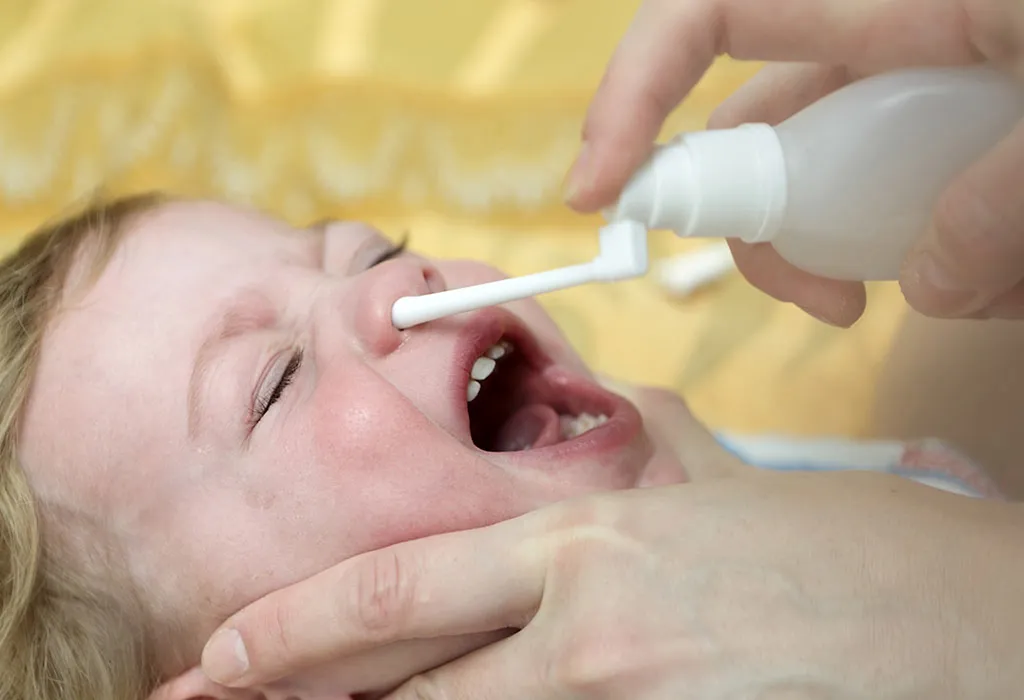
When using saline drops for your baby, it’s crucial to prioritize their safety. Here are some important precautions to keep in mind:
1. Choose Safe and Trusted Saline Drops
- Select saline drops specifically designed for babies. Look for products that are free from additives, preservatives, and medications.
- Check the label for age recommendations to ensure the drops are suitable for your baby’s age group.
- Purchase saline drops from reputable brands or consult your pediatrician for recommendations.
2. Proper Storage and Handling
- Store saline drops in a cool, dry place, away from direct sunlight.
- Keep the bottle tightly sealed to prevent contamination.
- Avoid sharing the bottle with others to reduce the risk of cross-infection.
3. Nasal Hygiene
- Before administering saline drops, wash your hands thoroughly to maintain cleanliness.
- Gently clean your baby’s nose using a soft, damp cloth or saline solution to remove excess mucus before application.
4. Dosage and Technique
- Follow the instructions provided by the manufacturer or your healthcare provider for the appropriate dosage.
- Administer the saline drops using a dropper or nasal spray as directed.
- Ensure the dropper or spray tip is clean before each use, and avoid directly touching your baby’s nose with the applicator.
5. Disposal
- Dispose of any unused saline drops according to the manufacturer’s guidelines.
- Do not reuse or share saline drops to prevent the risk of contamination.
Remember, if you have any concerns or questions about using saline drops for your baby, consult your pediatrician for personalized advice. Your baby’s health and well-being are of utmost importance.
5 Alternatives to Saline Drops
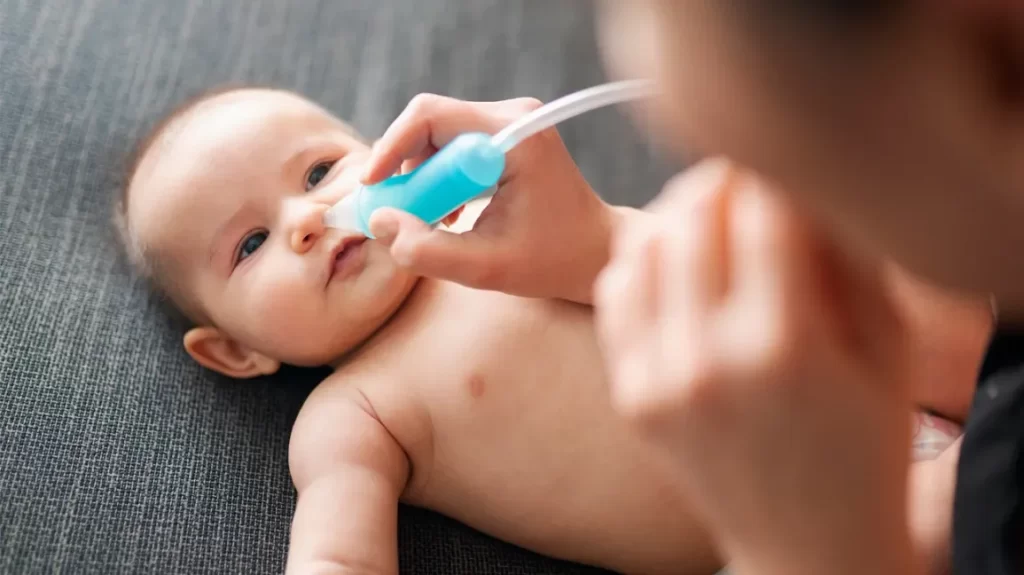
When it comes to relieving infant nasal congestion, saline drops are often recommended. However, there are also alternative methods and remedies that can help alleviate your baby’s blocked nose.
Let’s explore some of these alternatives:
1. Nasal Suction
- Nasal suction, or using a bulb syringe, is a common method to clear a baby’s congested nose.
- Gently squeeze the bulb, place the tip at the entrance of the nostril, and release the grip to suction out the mucus.
- Remember to clean the bulb syringe thoroughly after each use.
2. Humidifiers
- Using a humidifier in your baby’s room can help moisten the air and reduce nasal congestion.
- Opt for cool-mist humidifiers to ensure safety.
- Keep the humidifier clean and follow the manufacturer’s instructions for proper usage.
3. Elevate the Head
- Raising the head of your baby‘s crib or bassinet with a slight incline can help reduce congestion.
- This elevation can promote better drainage of the nose and decrease discomfort during sleep.
4. Steam
- Create a steam-filled bathroom by running a hot shower.
- Sit in the steamy room with your baby for about 10-15 minutes, allowing the warm mist to help loosen nasal mucus.
- Be cautious of the hot water, and ensure your baby is comfortable and not overheated.
5. Saline Solution
- If you prefer not to use saline drops, you can make a homemade saline solution by mixing a quarter teaspoon of salt with eight ounces of distilled water.
- Use a clean dropper or nasal spray bottle to administer a few drops or sprays into each nostril.
Remember, it’s essential to consult with your healthcare provider before trying any alternative methods. They can provide personalized guidance and ensure the safety and effectiveness of the chosen remedy.
By exploring these alternatives to saline drops, you can find a solution that works best for your baby’s comfort and congestion relief.
When to Seek Medical Advice

It is important to pay attention to your baby’s nasal congestion and seek medical advice if it persists or worsens. Here are some guidelines to help you determine when it’s time to consult a healthcare professional:
Consult a Healthcare Professional if:
1. Nasal congestion lasts for more than two weeks and does not improve.
2. Your baby is experiencing difficulty breathing or shows signs of respiratory distress.
3. They have a high fever along with nasal congestion.
4. The nasal discharge turns yellow or green and is accompanied by a foul smell.
5. Your baby experiences pain or discomfort due to nasal congestion.
6. They have recurring ear infections along with nasal congestion.
7. Your instinct tells you that something is not right, and you are concerned about your baby’s health.
Remember, healthcare professionals are trained to identify and address any underlying medical conditions causing nasal congestion in babies. Don’t hesitate to seek their expertise and guidance to ensure your little one’s well-being.
The Final Note: How To Use Saline Drops For Babies
In conclusion, understanding how to use saline drops for babies is essential for providing relief to your little one’s nasal congestion. By learning the safe and effective administration of saline drops, parents can help alleviate their baby’s discomfort and ensure better breathing.
From addressing the causes and symptoms of infant nasal congestion to selecting the right saline drops, we have provided comprehensive insights to aid parents in supporting their baby’s well-being. With the gentle yet powerful relief that saline drops can offer, parents can say goodbye to sleepless nights and hello to easier breathing for their precious bundle of joy.
Remember, addressing nasal congestion promptly and effectively with saline drops can make a significant difference in your baby’s comfort and overall health.







